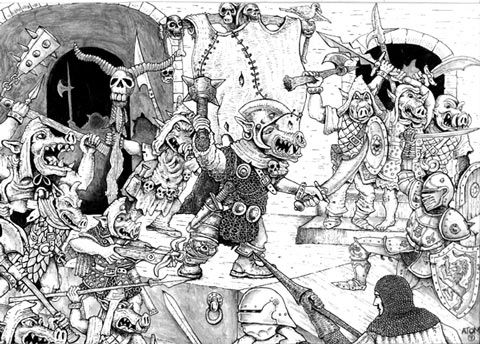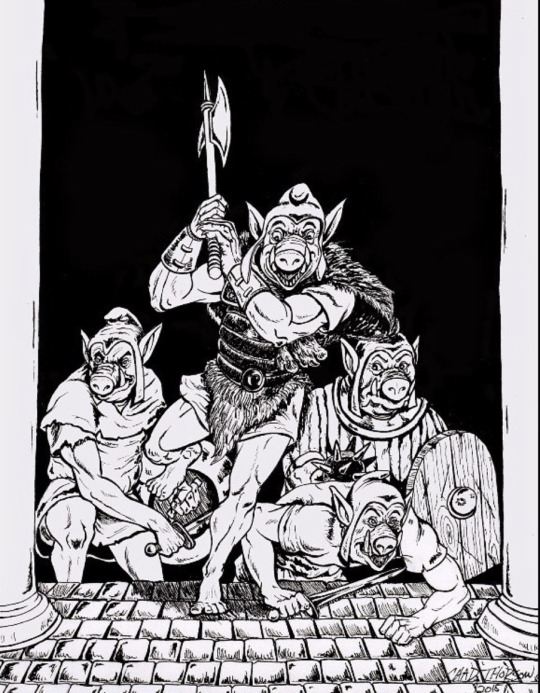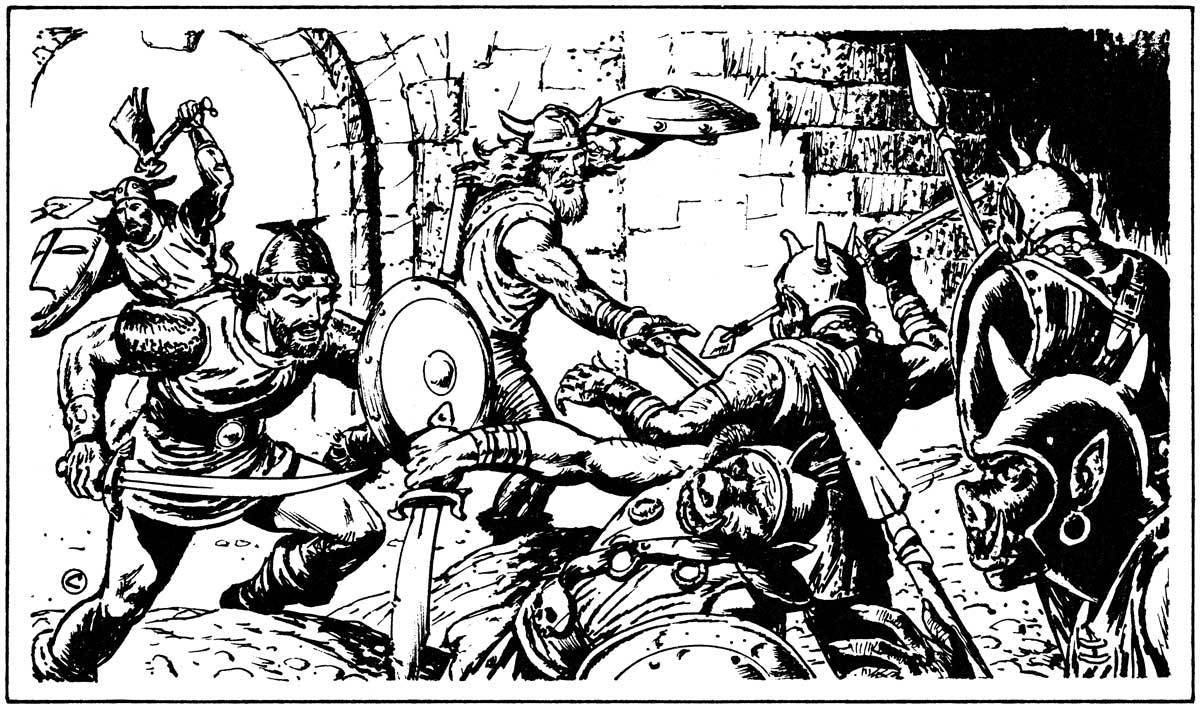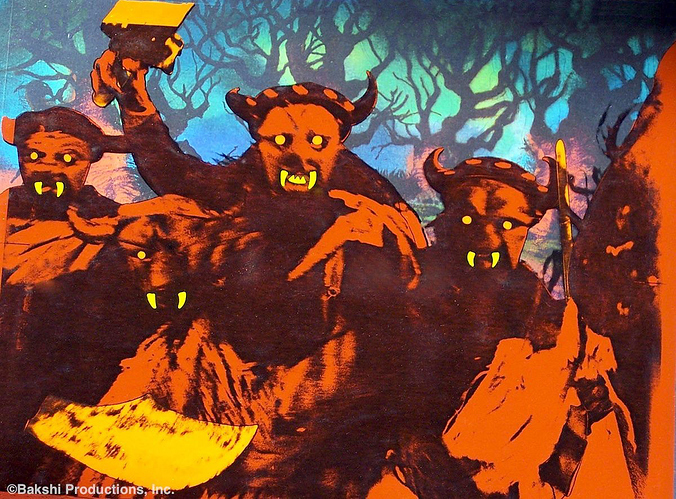This is patently false, Merl.
In White Box OD&D, Orcs are barely described past their mechanical functions (pp. 7-8 of Monsters & Treasure).
It says they live in tribes, “keeping in mind inter-tribe hostility” (not INTRA). Orc tribes fight each other, but they don’t typically fighting within their own tribe except as sport (which all humanoid civilizations do - we all wrestle and establish hierarchies).
They live in lairs that are either caves (4-in-6) or villages (2-in-6), which can be protected by sentries, distches, and palisades. Villages can also have catapults, and high central towers. They associate with fighting-men (heroic types, IE higher level fighters), dragons, ogres, and trolls (and goblins, of course). Seems like they want to protect what they’ve got, and who they’ve got. Although they are chaotic, meaning the strongest leaders will lead rather than something like hereditary or elected leaders, that doesn’t mean they are stupid or mindlessly aggressive.
On p. 8 we read, “Orcs do not like full daylight, reacting as Goblins do”. A clear reference to Tolkein orcs, which only ever once or twice fell into full, riotous in-fighting (being starved, or when one goblin stabbed an orc, for example). This is basically the only pre-D&D reference we get to orcs in the game material, as D&D orcs resemble almost nothing of the real-world mythological “orc”, which is usually either a sea creature or literally a “demon or monster”.
In BASIC D&D, p. B40, we read more of their evolution in the game. They are described as ugly human-like creatures. They still fight poorly in daylight and have bad tempers. They kill for their own amusement, but are afraid of larger and stronger things. Orc leaders gain position by fighting and defeating others (again, Chaotic, but not stupid, or mindless). Interestingly, they do not understand how to use mechanical things like catapults (except their leaders), a clear change from the Tolkein-inspired war-bred monsters.
Here we again see that, “Members of different tribes are not usually friendly with each other, and may start fighting unless their leaders are present. An orc lair has only one tribe.” Clearly, in-fighting isn’t the issue. Inter-tribal warfare is. BUT the orcs can be kept in line if a leader is present, either by fear, respect, or harsh discipline and training. Again, chaotic, not mindless.
In ADVANCED D&D, orcs are described in even more detail. They are now a mammalian species, no longer “human-like creatures”, and believe that to survive they must expand hteir territory. THEY are expansionists, they are not CONTROLLED by expansionists! They resemble primitive humans with “grey-green skin, coarse hair, slightly stooping posture, low jutting forehead, and a snout instead of a nose … though comparisons between this facial feature and those of pigs are exaggerated and perhaps unfair”. Perhaps unfair, hinting very strongly at a more complex societal structure than our human perspective (as PCs) allows.
Orcs speak Orcish, a language derived from older human and elvish languages (another reference to Tolkein and the corruption of the elves). They have a “historic enmity against elves and dwarves”, and there are many references to wearing things human find unpleasant, not obeying human rules of war and rules of engagement and chivalry.
“It is often believed that orcs are so bloodthirsty and cruel that they are ineffective tacticians and that they would rather be vicious than victorious. Like most stereotypes, this is highly misleading; it is true for some orcs tribes but not for all. Many orc tribes have waged wars for decades and have developed a frightening efficiency with battle tactics.” This is a direct quote. The PLAYER CHARACTERS might believe that orcs are horrible stupid monsters, but they are not. If a PLAYER comes to believe those stereotypes, the game itself openly states that they are stereotypes, and not necessarily accurate.
Further down, the MM notes that they are still weaker in sunlight, still use tribal formations (not not always), still use villages and caves with ditches, log ramparts and palisades, towers, gates, ballista, and catapults. They are again the martial race of Tolkein in many ways. But they also have leaders, subleaders, shamans (indicative of religion and culture).
“Orcs are aggressive. They believe other species are inferior ot them and that bullying and slavery is part of the natural order. …Orcs believe that battle is the ideal challenge, but some leaders are pragmatic enough to recognize the value of peace, which they exact at a high price. If great patience and care are used, orc tribes can be effective trading partners and military allies.” Hmm… Mindless? I think not!
“Orcs value territory above all else; battle experience, wealth, and number of offspring are other major sources of pride. Orcs are patriarchal; women are fit only to bear children and nurse them. Orcs have a reputation for curelty that is deserved, but humsn are just as capable of evil as orcs.”
It would definitely seem to me that orcs are not an analogue for the warrior race trope which usually required a “more sophisticated being” to successfully weaponize the violent savages. They are violent and savage, but they do not require “domestication”. In fact, the only thing they actually align with are the colonizers and racists themselves. Orcs are monsters, and so are people.
But orcs were never meant to resemble a group of real-world people. They are decidedly non-human (NOT DEMI-HUMAN, NON-HUMAN), and any real world cultures are better encompased with the Human race.
In sum, any association with orcs and the victims of history is purely within the readers’ minds. The actual text doesn’t support that whatsoever.
AC











